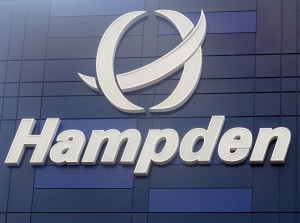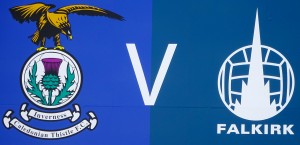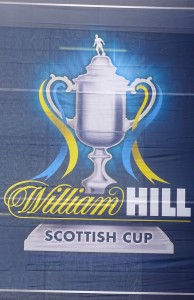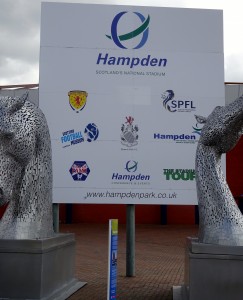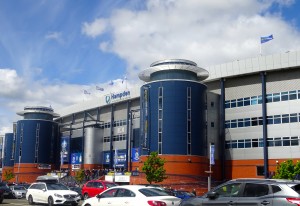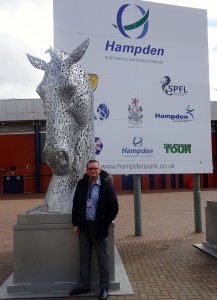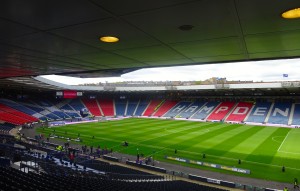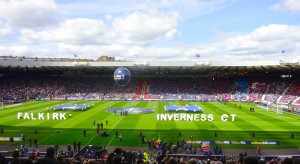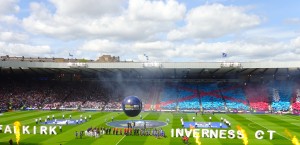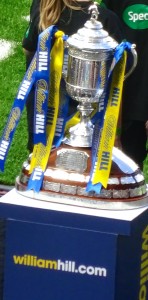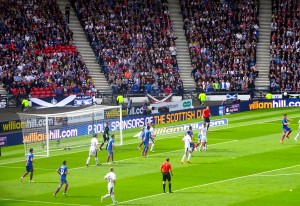My heart aches, and a drowsy numbness pains
My sense, as though of hemlock I had drunk,
Or emptied some dull opiate to the drains
One minute past, and Lethe-wards had sunk
‘Tis not through envy of thy happy lot,
But being too happy in thy happiness,
That thou, light wingèd Dryad of the trees,
In some melodious plot
Of beechen green and shadows numberless,
Singest of Summer in full throated ease.
(John Keats, 1795-1821, from “Ode to a Nightingale”)
.
.
.
Saturday 30th May 2015
William Hills Scottish FA Cup Final
Inverness Caledonian Thistle 2
Marley Watkins 39,
James Vincent 86,
Carl Tremarco sent off, 75,
Falkirk 1
Peter Grant 80,
Referee:- William Collum Attendance:- 37,149
It was an early start to the day, but by 7.30am, John, Jack, Daz and Eddie, the four intrepid adventurers were all gathered just outside Nottingham for the assault on Scotland. I had hired a VW Passat for the weekend and this comfortable, if somewhat sluggish chariot, hurtled us northwards throughout the morning.
I suppose we had chosen this match for different reasons. For some, it was a first visit to Hampden Park, Scotland’s national stadium, but for me, it was the opportunity to see a Scottish Cup Final uncluttered by Old Firm rivalry and, perhaps, the chance to see a game of football without the harsh accompaniment of pound signs! We were pleasantly surprised to find how easy it was, firstly to locate the stadium, and secondly to access the car park right outside the main reception area.
We had chosen to go for hospitality. It wasn’t cheap, nor was it even the cheapest package on offer. We each paid £99 plus VAT , but it was well worth it! There were maybe one hundred and fifty of us seated very comfortably in the hospitality suite, surrounded by TV monitors showing a variety of sport. At our table was James Innes, chairman of Wick Academy FC and with him was his son, a quiet lad with an alert sense of humour!. James told us that Wick Academy had its fair share of ‘hoppers’ because it was the most northerly outpost of football on the mainland of Scotland. He did say that most of the ones he met barely had two pennies to rub together and that he was somewhat surprised to find a bunch of hoppers in hospitality! Next season, we will definitely visit Wick! Fly to Aberdeen, he said and fly from there to Wick! A lot of his clients, he told us, liked to fly to Inverness and hire a powerful motor and let rip the dogs of war on the quiet road to Wick! It is a nearly as far from Wick to Hampden as it is from Northamptonshire to Hampden!
Before the match, we enjoyed a tour of the outside of the stadium. There have been three Hampden Parks. Queens Park FC played at the original Hampden Park from 1873. The first Scottish FA Cup final was played there in 1874 and the first international match (against England) in 1878. It was called “Hampden” Park, so it is said, because an Englishman’s house overlooked it. John Hampden was a Roundhead in The English Civil War.
The second Hampden Park was opened in 1884 after The Cathcart Railway Company announced its intention to take up land for a railway extension. Queens Park FC soon wanted to extend the stadium, but when this was found to be impracticable, they set about creating the third ground of the same name which opened in 1903. Third Lanark took over the existing ‘Hampden Park’ (re-named it Cathkin Park) and remained there until their demise in 1967. Both Jack and I had been to Cathkin Park for a match a couple of seasons ago and although the stands had been removed, the terracing could be clearly identified and the majesty of the place was still visible!
Hampden Park was a mighty arena with a capacity which eventually rose to 150,000. The record crowd for a match at the stadium is 149,415 for the Scotland v England match of 1937. By 1980, however, the capacity had been reduced to 81,000 and several years later, a major refurbishment has reduced that capacity even further to the present 52,000. It is The Headquarters of The Scottish FA and The Scottish Professional Footballers Association, amongst others and yet for all its grandeur, it has a low centre of gravity, sitting almost flush with the skyline, the twin towers at the main reception resembling nothing so much as giant handles to grasp and move the stadium around!
Daz modelling outside the stadium!
The two teams contesting the final were hardly from the top drawer of Scottish football! Inverness Caledonian Thistle were a Highland League club until 1994, in fact they were TWO Highland League clubs, who amalgamated in 1994 to press successfully for a place in The Scottish League. Fifteen years later, they were in The Scottish Premier League.
Falkirk come from more established stock, having been formed in 1876 and gaining admission to The Scottish League in 1902. Their last success, however, was the Scottish FA Cup in 1957 and two runners-up places in 1997 and 2009. Today, playing a division below Inverness in The Scottish Championship, they were definitely the under-dogs. Peter Houston, however, the manager of Falkirk, had a record in his sights. He could become only the third Scottish manager to win The Scottish FA Cup with two different clubs!
I was impressed with The Scottish FA and the manner in which they promoted The Cup Final. Neither of these two clubs have a large fan base, maybe three or four thousand regularly attend at either ground, so to assemble a crowd in excess of thirty-seven thousand to support the event must have taken some marketing! The hospitality that we enjoyed was efficiently managed. I have enjoyed hospitality at Arsenal and Ajax and at Cheltenham and Shrewsbury and this, although it was the basic package, stood up well to other experiences. On the pitch, the pre-match entertainment was electric, with flares and crackers and a large balloon and a ground that was only two thirds full looked much more full than that!
The first half was something of a bore with both sides testing each other out and each reluctant to throw forward too much artillery. Caley scored after 39 minutes through Marley Watkins, who deftly picked his way across the penalty area and tapped the ball underneath the advancing goalkeeper and into the net.
In the second half, the pace picked up. Falkirk suddenly found an extra gear and there was more urgency in their play. After seventy-five minutes, the Inverness defender Carl Tremarco, tripped when attempting to control a through ball and left a Falkirk striker through on goal. He was sent off for denying a goalscoring opportunity when he clumsily brought the striker down, but the resultant free kick, from just outside the area, failed to bring any reward. Reward there was, however, on eighty minutes when the influential Peter Grant rose high at the far post to guide a header firmly into the net and the sides were level to the great relief of the Falkirk faithful, who raised their white banners in jubilation.
It was not to be, however, some six minutes later with extra time beckoning, a mistake by the Falkirk custodian, fumbled the ball into the path of the galloping James Vincent who had covered the length of the pitch to smash the ball into the unguarded net and give Caley-Thistle their first ever Scottish FA Cup triumph.
Somehow, it didn’t have the swashbuckling ring of “Super Cally Go Ballistic Celtic are Atrocious” – a headline framed in the foyer of The Caledonian Stadium and referring to Inverness Caledonian Thistle’s famous 3-1 victory at Celtic Park in 2000. It mattered not! Within minutes, the Falkirk support had melted away and the winners enjoyed their moment of triumph along with their fans. Back in hospitality, the rest of my group girded their loins with alcohol – Jack sampling a large portion of Ardbeg whisky from Islay – and we contemplated the long journey back to England.
Just outside Derby, on The A50, with the major portion of the journey completed, flashing blue lights in my mirror brought the realisation that the long arm of the law had eventually caught up with me. I slowed and stopped at a convenient lay-by and awaited the presence of the omniscient traffic officer, who’s opening gambit was “How would you like to lose your licence, sir?” He said that he had been following me at average speeds of 98 miles per hour and that I was a menace to other road users and to my passengers. I took all this in with equanimity and a somewhat hangdog expression, saying as little as possible and was utterly staggered when he let me off with a warning! Needless to say, I drove the rest of the journey at well within the national speed limits and arrived on my doorstep, having decanted the rest of the party en-route, at just after midnight.
It had been a cracking day’s football!
This season – Matches:- 231 New Grounds:- 138
TOTAL – Matches:- 3,202 New Grounds:- 1,092
Mirabile dictu!

